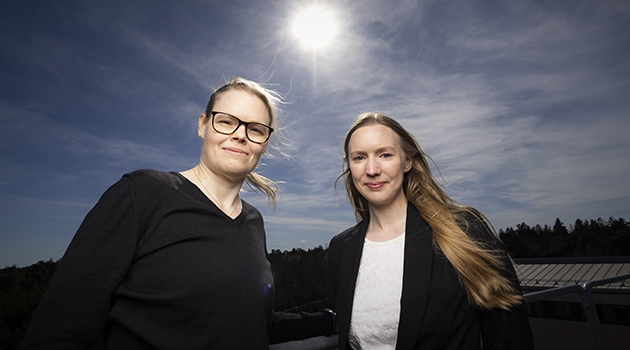Electric aviation makes new demands on future airports

Karin Thomas and Jennifer Leijon are conducting research on how future airports served by electric aircraft could obtain a secure supply of sustainably produced electricity.
In just a few years all domestic aviation in Sweden is due to be fossil-free. Electric aircraft could be part of the solution. However, this in turn makes new demands on airports, which must be able to offer good infrastructure for charging the planes. Karin Thomas and Jennifer Leijon at the Department of Electrical Engineering are examining ways of ensuring that future airports have the necessary electricity supply.
“We’re actually looking at the entire energy system at the airport and ways of making it possible to charge electric planes. As things stand at present, with current flight schedules, they would have very little time to charge when stationary on the ground. In the project, we have worked with Visby Airport, Skellefteå Airport and other researchers at RISE Research Institutes of Sweden and Uppsala University,” says Thomas.
The Swedish Energy Agency has provided funding for the project, which is called RES-flyg (Resource-efficient system solutions for airports with high share of electric aviation), and the final report will be published in May. One of the conclusions is that the airports face multiple challenges – but that electric aviation and local electricity production also create great opportunities.
“We expect to see an increased need for electricity at airports. Many airports are very interested in acquiring solar cells and battery storage facilities to meet the growing need for electricity for charging electric aircraft and other electric vehicles,” says Leijon.
Local electricity production and battery storage are unlikely to be able to answer all of an airport’s energy needs, but the researchers believe they could play a supplementary role. The transport involved is not limited to some of the aviation, it also includes connecting traffic and vehicles at the airport itself. In view of this, it is important that all the energy is sustainable and renewable.
“What we have used in our models is solar power, but of course there are a few problems with solar panels at airports, notably electromagnetic interference and reflected glare. So that’s probably the main handicap for solar cells at present. Though there are airports that have solar power production, so it feels as if there ought to be some sort of solution,” Thomas says.
Aircrafts in the process of development
The project’s models are based on types of aircraft that are in the process of development, as there are no very large electric aircraft in regular service yet. The current estimated range of an electric aircraft is 300 km and they can take far fewer passengers than a conventional aeroplane. This is because the batteries are very heavy. Despite this, the researchers believe the range and number of passengers will be able to increase in the future and they expect electric aviation to play an important role, particularly in sparsely populated areas.
“I believe it will change our travel patterns, or travelling at regional level. New routes will be created and it will be possible to use smaller, regional airports in a way that doesn’t happen now. And perhaps it will be possible to eliminate some road traffic to places not served by rail, for example,” Thomas says.
However, it will be at least a few years before we can buy tickets for a purely electric flight over longer distances. That said, in the researchers’ opinion, the ambitious public goals for substantially reduced climate impact from aviation could help to accelerate progress.
“We have ambitious national goals for aviation. In 2030, all domestic aviation in Sweden is due to be fossil-free and in 2045 the goal is for all aviation in Sweden to be fossil-free. Here, electric aviation is an alternative, though not the only option,” Leijon concludes.
Åsa Malmberg
